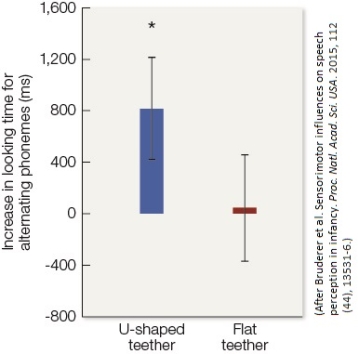Essay
Refer to the figure.
 Figure. Average looking time was measured while broadcast phonemes either alternated (between Hindi /d_/ and /dj/) or stayed the same (repeating /d_/, or repeating /dj/). Observations were taken when infants sucked on either a U-shaped teether that allowed free tongue movement (left bar) or a flat teether that immobilized subjects' tongues (right bar). Scores greater than zero indicate a preference for the alternating phonemes. Error bars denote Standard Error of the Mean. The asterisk marks a significant difference from zero.
Figure. Average looking time was measured while broadcast phonemes either alternated (between Hindi /d_/ and /dj/) or stayed the same (repeating /d_/, or repeating /dj/). Observations were taken when infants sucked on either a U-shaped teether that allowed free tongue movement (left bar) or a flat teether that immobilized subjects' tongues (right bar). Scores greater than zero indicate a preference for the alternating phonemes. Error bars denote Standard Error of the Mean. The asterisk marks a significant difference from zero.
Infants spend more time looking at a loudspeaker, on average, if they detect an acoustic change within a stream of repeating sounds that it broadcasts. Based on the figure from Bruderer et al.'s 2015 study of speech perception by 6-month-old English-speaking infants (above), does the articulatory system of infants influence whether the babies hear phoneme distinctions between non-English consonants? Explain briefly.
Correct Answer:

Verified
Correct Answer:
Verified
Q22: Which kind of sound contrast differs along
Q23: What general cognitive skill may support adaptation
Q24: Refer to the figure.<br> <img src="https://d2lvgg3v3hfg70.cloudfront.net/TBO1216/.jpg" alt="Refer
Q25: Imagine that you were a participant in
Q26: Suppose researchers ask participants to identify syllables
Q28: Which statement accurately describes a similarity or
Q29: Judging from the psycholinguistic evidence, what is
Q30: Suppose you are trying to automate the
Q31: Describe examples of evidence that show how
Q32: What was the result when researchers used